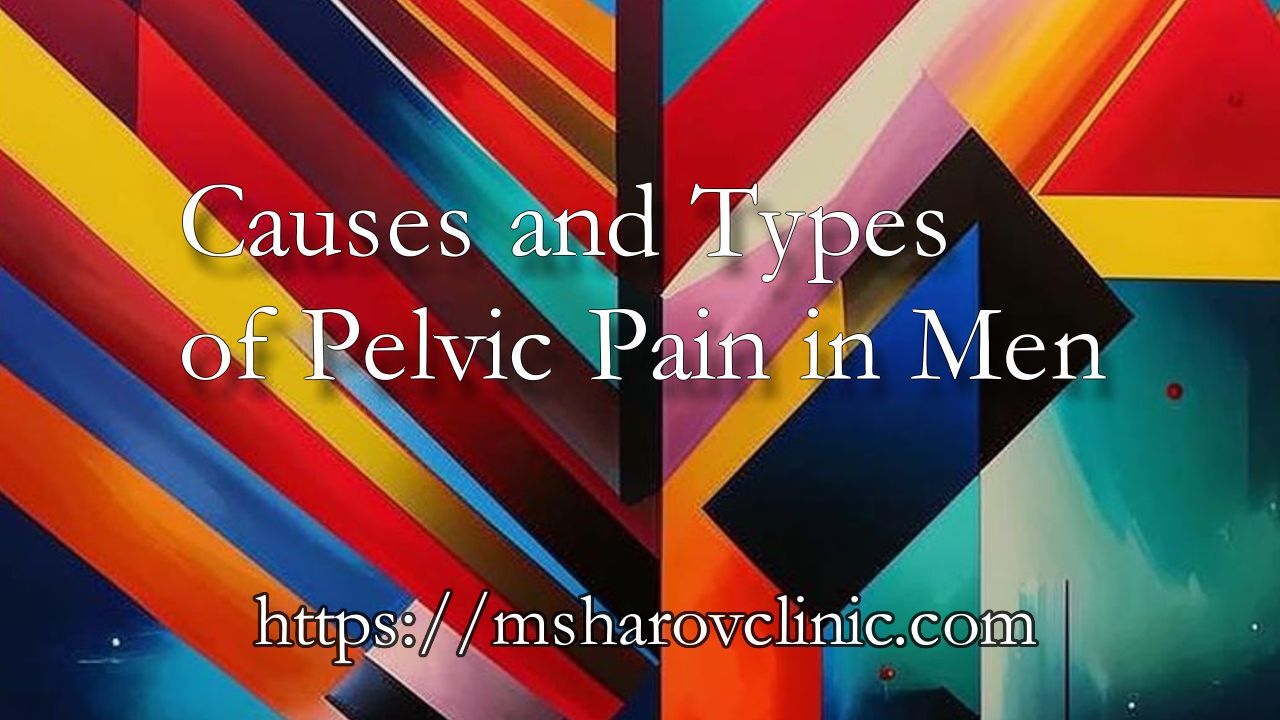Pelvic pain is a common problem among men that can range from mild discomfort to severe sensations significantly reducing the quality of life. This pain occurs in the lower abdomen, between the navel and groin, and often serves as a symptom of various diseases. It’s important to understand that it may be associated with several body systems such as the urogenital, musculoskeletal, nervous, and digestive systems. Let’s explore the possible causes of this issue and its connection to urological conditions.
---
Pelvic Pain in Men: A Variety of Causes
Pelvic pain in men can arise for different reasons, each requiring an individual approach to diagnosis and treatment. Here are some main factors that can cause this problem:
Urogenital System
Diseases of the urogenital system are one of the most frequent causes of pelvic pain in men. Among them are the following conditions:
- Urinary tract infections (UTIs) - bacterial infections affecting the kidneys, ureters, bladder, or urethra.
- Prostatitis - inflammation of the prostate gland, which can manifest both acute and chronic symptoms.
- Kidney stones - salt crystals formed in the kidneys or bladder, causing intense pain when moving through the urinary tract.
- Cystitis - inflammation of the bladder lining accompanied by abdominal pain and urination problems.
- Chronic pelvic pain syndrome - a condition characterized by prolonged pelvic pains without any obvious organic cause.
Musculoskeletal System
Problems with muscles, ligaments, and joints can also lead to pelvic pain. For example, muscle strains, bone injuries, or arthritis can cause discomfort and soreness.
Nervous System
Damage to nerve endings or inflammatory processes in the nervous system can provoke pelvic pain. This can occur due to trauma, surgery, or chronic diseases.
Digestive System
Certain gastrointestinal disorders, such as colitis, diverticulitis, or intestinal infections, can cause painful sensations in the pelvic area.
Pelvic Pain in Men
---
Urological Aspects of Pelvic Pain
When discussing the relationship between pelvic pain and urology, it's essential to consider that many diseases of the urogenital system can be accompanied by pelvic pain. These include:
- Prostate inflammation (prostatitis) - one of the most common conditions causing pelvic pain in men. It involves an inflammatory process in the prostate that can be either acute or chronic.
- Infectious diseases of the urinary system, such as cystitis and urethritis, often result in pain in the lower abdomen and burning during urination.
- Kidney and bladder stones - stone formation leads to severe pain, especially when they start moving along the urinary tract.
- Chronic pelvic pain syndrome - a long-term condition where pain persists even after the underlying cause has been eliminated. This syndrome requires comprehensive treatment involving medication, physical therapy, and psychological support.
Pelvic Pain and Urology
---
Pelvic pain in men is a multifaceted symptom that demands careful attention and timely consultation with a doctor for accurate diagnosis and appropriate treatment. Regardless of whether the pain is related to urogenital, musculoskeletal, nervous, or digestive issues, seeking professional help is crucial to determine the cause and choose the best method of therapy. Only a professional approach will effectively address the problem and improve the patient's quality of life.
---
Pelvic Pain in Men: A Variety of Causes
Pelvic pain in men can arise for different reasons, each requiring an individual approach to diagnosis and treatment. Here are some main factors that can cause this problem:
Urogenital System
Diseases of the urogenital system are one of the most frequent causes of pelvic pain in men. Among them are the following conditions:
- Urinary tract infections (UTIs) - bacterial infections affecting the kidneys, ureters, bladder, or urethra.
- Prostatitis - inflammation of the prostate gland, which can manifest both acute and chronic symptoms.
- Kidney stones - salt crystals formed in the kidneys or bladder, causing intense pain when moving through the urinary tract.
- Cystitis - inflammation of the bladder lining accompanied by abdominal pain and urination problems.
- Chronic pelvic pain syndrome - a condition characterized by prolonged pelvic pains without any obvious organic cause.
Musculoskeletal System
Problems with muscles, ligaments, and joints can also lead to pelvic pain. For example, muscle strains, bone injuries, or arthritis can cause discomfort and soreness.
Nervous System
Damage to nerve endings or inflammatory processes in the nervous system can provoke pelvic pain. This can occur due to trauma, surgery, or chronic diseases.
Digestive System
Certain gastrointestinal disorders, such as colitis, diverticulitis, or intestinal infections, can cause painful sensations in the pelvic area.
Pelvic Pain in Men
---
Urological Aspects of Pelvic Pain
When discussing the relationship between pelvic pain and urology, it's essential to consider that many diseases of the urogenital system can be accompanied by pelvic pain. These include:
- Prostate inflammation (prostatitis) - one of the most common conditions causing pelvic pain in men. It involves an inflammatory process in the prostate that can be either acute or chronic.
- Infectious diseases of the urinary system, such as cystitis and urethritis, often result in pain in the lower abdomen and burning during urination.
- Kidney and bladder stones - stone formation leads to severe pain, especially when they start moving along the urinary tract.
- Chronic pelvic pain syndrome - a long-term condition where pain persists even after the underlying cause has been eliminated. This syndrome requires comprehensive treatment involving medication, physical therapy, and psychological support.
Pelvic Pain and Urology
---
Pelvic pain in men is a multifaceted symptom that demands careful attention and timely consultation with a doctor for accurate diagnosis and appropriate treatment. Regardless of whether the pain is related to urogenital, musculoskeletal, nervous, or digestive issues, seeking professional help is crucial to determine the cause and choose the best method of therapy. Only a professional approach will effectively address the problem and improve the patient's quality of life.

